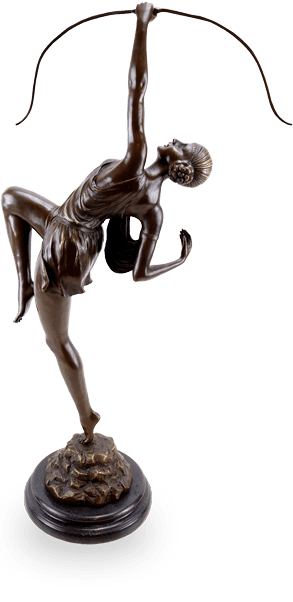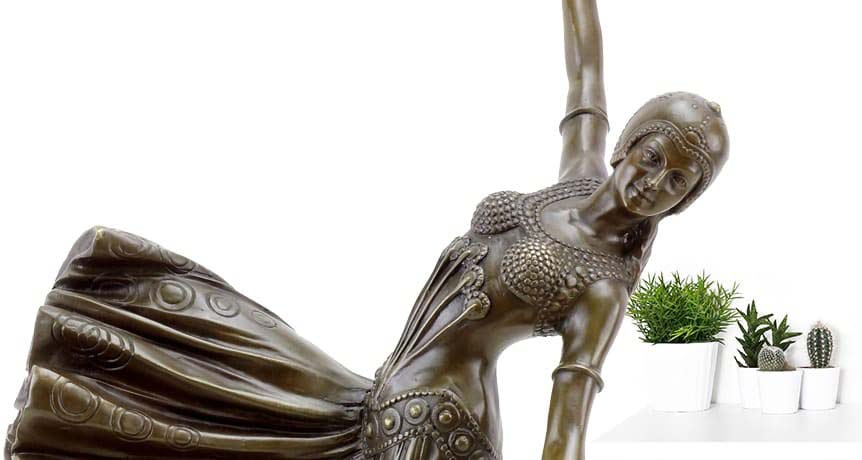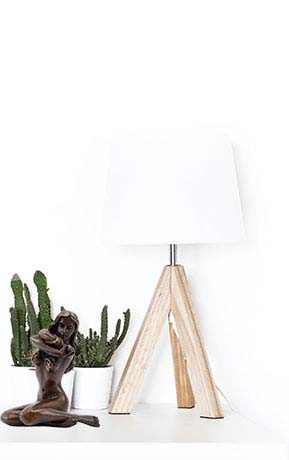What you should know about bronze sculptures

What is bronze?
Bronze is an alloy dating back to 4500 BCE composed of varying amounts copper and tin. Though pre-dated by another bronze alloy combining copper with arsenic, tin bronze has remained relatively unchanged since its discovery in the 3rd millennium BCE. Two forms of tin bronze were used during the Bronze Age, ‘mild bronze’ – which was 6% tin, hammered thin, and used for objects such as armor – and ‘classic bronze’, a composite with 10% tin that is still used for casting objects today.
The alloy is particularly strong, ductile, and, because its oxidation process prevents corrosion, extremely durable. The material is in fact so durable, that despite the earliest known cast bronze dating back to 2500 BCE, there are comparatively few examples of large bronze casts because, as boundaries changed and kings fell, they were often melted down and repurposed. The alloy has been used around the world since antiquity, including by the ancient Greeks, who considered it the highest form of sculpture and were the first to scale bronze figures to life-size. It remains the most desired material for monumental statuary.
As bronze ages, verdigris – a blue-green patina – forms on the surface. This is caused by the oxidation of the alloy during which a very superficial layer reacts to the oxygen in the air and becomes copper carbonate. This verdigris acts as a shield preventing any significant corrosion, but can also be easily removed without harming the sculpture’s integrity or durability. This should be done with a
specialized bronze cleaner and a soft sponge. Bronze is an inherently durable alloy which, with some care, can retain its original condition and quality for decades and centuries.
What should I look for in a bronze sculpture?
Though Bronze has remained relatively unchanged since the alloy combining copper and tin was first discovered, a sculpture’s quality is still very dependent on how well it is cast. Various defects, such as gas porosity – the formation of bubbles within the cooled casting – or coldfront – the imperfect fusion of two fronts of liquid metal – can affect the alloy’s strength, appearance, and durability. Important things to note when determining the quality of a bronze sculpture include the exactness of the casting to the artist’s model, particularly its surface texture quality and the accuracy of subtle details such as fingers. The patina which develops naturally on the surface of the sculpture can indicate the quality of the alloy used. The color of the patina can vary from reddish to warm brown, green, or even yellow depending on the amount of copper in the alloy. Regardless of its color or whether it is naturally occurring or has been induced with chemical substances, the patina should be even and richlyhued. Particularly thick or dark patinas are often used to hide flaws in lower-quality casting.
How are bronze sculptures made?
The lost-wax technique is the most common technique for creating bronze figures and sculptures. Though the exact process varies from foundry to foundry, the technique has been relatively standard since its first use in c. 3700 BCE. The artists begins with a model for which a mold is made. A soft material such as silicone is used for the inner mold, which must be malleable enough to produce an exact negative of the original object. The outermold is rigid, often made of plaster. Molten wax is then poured into the mold thinly coating its inner surfaces. After it has cooled the wax is removed from the mold and ‘chased’ – perfected to remove any flaws or evidence of casting – wax rods are added to form channels through which the molten bronze can flow and gas can escape. A rigid cast, again often plaster, is built around the wax mold and the entire object is fired in a kiln. This both solidifies the plaster and melts the wax which drips out of the mold through the channels. This leaves a prefect negative of the artist’s object into which the liquid bronze is poured.
After it is cooled, the casting is removed from its plaster mold, the bronze which formed in place of the wax rods is removed, and the surface is ‘chased’ once more, polished, and sealed. A well-cast bronze sculpture is weatherproof and extremely durable.
What are the different kinds of bronze sculptures?
Bronze can be used to create nearly any kind of sculpture so long that its mold can withstand the casting technique. Since its metallurgic development, the tin-copper bronze alloy has been used for objects such as sculptures, weaponry, vessels, and jewelry. The most renowned objects, however, are the sculptures of ancient Greece. By combining their aesthetic of idealized naturalism and the relatively new lost-wax method, Greek sculptures were able to create statues unparalleled in size and detail. These sculptures are still revered today as one of the pinnacles of art making. The bronze tradition was neglected following the fall of Rome and remained dormant in the West until it was revived during the Renaissance’s quattrocento and used to fabricate sculptural doors for cathedrals and churches. By the High Renaissance it was once again considered as a fine art medium taught in the first art academies. As art moved away from classicism toward modernism, sculptors like August Rodin and Umberto Boccioni used the now-academic bronze medium to emphasize Avant Garde aesthetic and ideologies.
What are bronze figurines?
A figurine is a small ornamental figure. During the Rococo period handcrafted bronze figurines were designed to be ornamental and part of a room’s décor – a trend that was used to subtly display one’s status and wealth. Figurines remained popular, particularly among collectors, through the centuries. Because modern production processes allow for high-quality bronze figurines to be made at lower
costs, sculptures are increasingly accessible. The selection of bronze figurines available from Kunst und Ambient includes Classical, Modern, Art Deco, and Art Nouveau replicas as well as animal sculptures, military statues, garden ornaments, and erotic nudes.
What are animal sculptures?
Animal sculptures are zoomorphic (animal form) figurines. The motif is particularly challenging for artists and manufacturers because of the ingenuity and skill required to precisely sculpt and cast the contrasting textures and fine details. The animal sculptures offered by Kunst und Ambient vary in size – making them appropriate for rooms, terraces, gardens, and ponds – and in style to fit any décor from the most traditional to the most modern. Birds, bulls, cats, and elephants are the most popular animals for artists and art enthusiasts alike, but with such an extensive assortment, any animal lover is sure to find their favorite.
What do birds symbolize?
In most traditions birds have a deep symbolic significance. As a species they are associated often with freedom and transcendence between heaven and earth. Nearly every bird species, however, has its own sometime contradictory cultural and religious symbolism. For example, the Eagle signifies power, pride, guardianship, authority, and is a Christian symbol for salvation. The owl has represented wisdom as far back as ancient Greece. The peacock is a symbol of Christ’s resurrection, the Greek goddess Hera and pride. Bird sculptures are most commonly used to decorate fountains or gardens, but have recently become popular as indoor accessories.
What do cats symbolize?
Regarded as sacred by the ancient Egyptians, cats were domesticated nearly 4,000 years ago and have been the subject of figurines since at least the Middle Kingdom ca. 1981 B.C.E. and in many cultures were sacrosanct idols one kept in the home. Now cat sculptures play a more secular role as representation of the domestic housecat sitting on shelves or laying in the garden.
What do bulls symbolize?
Bulls appeared in cave paintings up to 17,000 years old and have been included in numerous cultural histories including Greek mythology and Christianity. In nonreligious texts and images the bull is mainly associated with male sexuality, virility, and physical power. It is, however, also a lunar symbol tied to femininity and was considered by the Egyptians to be the passive counterpart to the active lion.
What do elephants symbolize?
In Chinese mythology elephants are imbued with knowledge and strength. The raised trunk of an elephant is considered a sign of good fortune and, thus, elephant sculptures are often kept as a token for luck and good fortune.
How long have sculptures been produced?
The oldest known undisputed art objects – artifact altered by a human for an artistic purpose – date back to the Upper Paleolithic era some 50,000 years ago. The earliest figurines were the Venus of Hohle Fels, a female figure, and the Löwenmensch, a lion-humanoid, carved from stone some 35,00-40,000 years ago. The seemingly rudimentary objects were made by a people who had also developed finely crafted stone tools, bracelets, beads, and bone-flutes and were possibly made to serve a ritualistic or symbolic function. During its millennia-long development sculpture has became and remained an integral art medium. Today a sculpture can be created from a plethora of materials and is nearly unlimited in form.
Are bronze sculptures limited to particular styles or time periods?
Bronze sculptures can be adapted to nearly every epoch and genre and, thus, they will never go out of style. At the same time, the material’s modern elegance and high artistry allow for sculptures to be understated and unobtrusive, fitting any interior design. Modern and contemporary art – with its often abstract shapes – can be extravagant additions to gardens and terraces.
What are Viennese erotic nudes?
Viennese bronze sculptors tended toward erotic motifs and their nude sculptures are certainly part of that tradition. The artworks were quite common during the 19th and 20th centuries – though only Viennese sculptors were allowed to produce them. Because of the closing of many shops producing Viennese erotic nudes as well as the common practice of melting down the sculptures for weapons and ammunition during the World Wars, the motif is now much rarer than it was over one hundred years ago. Currently there are only a few producers still manually sculpting and casting these erotic nudes. Our collection includes wide-ranging assortment from such artists as Duprè, Lambeaux, Milo, and Zach.
Are all nudes Viennese erotic nudes?
The term ‘erotic nudes’ is given only to the Viennese bronze figures depicting nudes. There are, however, several other sculptors and styles of the female figure in suggestive poses. Many ‘suggestive’ nudes include mythical creatures, such as fauns or devils, depicted in various sexual acts with women (sometimes slaves) or a phallus. The motif was most commonly produced as décor in smoking rooms and as an object for the male gaze. Their high design quality and boundary-crossing aesthetics are exactly why they remain a notable and well-renowned sculptures.
What are contemporary and minimalist sculptures?
Contemporary art is an epoch of art after modernism in the 20th and 21st centuries. Minimalism is the reduction of art elements (line, color, shape, etc.) that was predominant in both modern and contemporary art. In contemporary or minimalist bronze sculptures, particularly of the human or animal figures, the forms are simplified toward clean lines accentuating movement – or its absence – and
rhythmic shapes. Common motifs include animals, individual human figures (most often female) either individually or in small groups. Figures are often shown in the midst of elegant movements such as dancing in order to emphasize their clean, flowing lines.
For what kind of décor is bronze sculpture?
Because of its millenia-long history in art and decoration as well as its beautiful aging-process, bronze sculptural decor is often thought of when decorating ones living or business space. Contemporary bronze sculptures include an extensive number of styles, motifs, and sizes to distinctly express one’s personal taste, whether it be a small erotic nude on a bedroom nightstand or a traditional gatekeepers in the garden. Contemporary bronze sculptures possess a unique expressiveness because of their material and casting technique and can fit in any home.
Where can one buy bronze sculptures?
Bronze sculptures and figurines can be bought both in our Dresden storefront as well as our online shop. All sculpture descriptions on our website include detailed, high-resolution photographs and information regarding the dimensions and weight as well as the artist, a description of its style, and its authenticity. This allows you to confidently shop from home at your own pace without having to transport the sculpture yourself. All sculptures are shipped to arrive both safely and quickly.
What should be taken into account when buying original works of art?
There are a few things to note when buying an original sculpture or one that is part of a limited edition. A certificate of authenticity should always be included with purchase. This certificate will include information regarding the particular edition from which it is a part, including the sculptures number and the year it was produced. Edition numbers are generally written to include the total number of
editions made – for example, 50/100 would mean the sculpture purchased was the 50th produced out of 100. The artist’s signature should be included somewhere on the sculpture itself. In our online Bronze Shop, every sculpture’s page includes detailed photos as well as information regarding its authenticity, certificates, and signatures.
Can I purchase a bronze sculpture from any website?
Purchasing art is a matter of trust, both in person and online. The internet can offer a remarkable selection of artworks from every medium and style of art, but it is important to purchase bronze artworks from a reliable retailer. Such retailers of bronze sculptures and figurines will have such a wide-range of styles and periods in their stock as well as all relevant information. This includes detailed descriptions and photographs as well as the dimensions and weight, the manufacturing method, and artistic process. When possible, short videos of the artist or the manufacturing process are included.
What is the difference between buying online or in person?
Bronze sculptures and figurines are meticulously created works of art with their own long history of both art and humankind. The process to create a bronze sculpture is very elaborate and, of course, begins with an idea. A simplified explanation is that an exact model is made by the sculptor of which an impression is taken (to create the mold) and the mold is cast, which can be done in different ways, though the most common one used now is the lost-wax method. Every bronze sculpture begins with an artist and an idea and only through artistry and the knowledge of methods passed down for thousands of years does the idea become a bronze sculpture. When buying art objects, one like to look closely, inspecting the textures and the surface shadows they casts under the light. Unfortunately one doesn’t have this option when buying a sculpture online. When purchasing a sculpture from the Bronze Shop all sculptures include numerous high-quality photographs to remedy this issue as much as is possible. A benefit of purchasing your bronze sculpture online, other than the photos, is the much wider range of styles, motifs, and sizes that are available. With such a large stock, its very possible that a new favorite artist or motif will be discovered.
Why should I buy bronze sculptures online?
The most obvious benefit to purchasing bronze sculptures online versus in person is the incredibly large assortment that can be offered online. Not only will you have the widest selection possible, when shopping online, but details can be better and more comprehensively presented online than by an on-site vendor. All artworks available at the Bronze Shop have be carefully selected, examined with a high-level of expertise and prudently researched. Additionally, all sculptures are returnable. The Bronze Shop offers editions and limited series’ of sculptures that can complete a collection or aesthetically please a first-time buyer. All information regarding shipping rates and times and our contact information can be found on every product page.
What are your shipping costs, return policies, payment options, etc.?
At the Bronze Shop, we are able to provide you with many other advantages such as shipping all figurines and sculptures free of shipping cost to your preferred delivery address. Free shipping and transparent pricing means there are no hidden costs! Not only will your sculpture ship for free, but we guarantee that your purchase will be dispatched within 48 hours (excluding holidays). With a shipping time average of 1- 2 days, that means your sculpture will arrive within a week – often within 3-4 days – of completing your order. A 14-day return policy allows you to return your purchase for any reason within two weeks.
All customers have the option of making a customer account or purchasing as a guest. Several payment options are available ranging from bank transfers and direct debit to Paypal and credit card or cash on delivery or installment payments.



